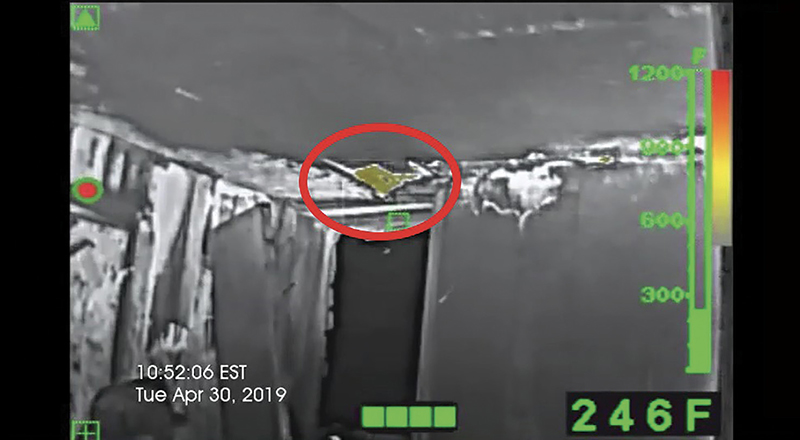Being a firefighter is one of the greatest jobs in the world—from the sense of pride you get when you put on the uniform on your very first day and report for duty to the time you retire. However, the various tasks that are required of you can be sometimes tedious and demanding and may not be your favorite, such as conducting overhaul.

Once the main body of the fire has been extinguished, the next task is conducting overhaul, which is primarily searching for and extinguishing hidden fires or remaining hotspots. Other activities in overhaul include placing the building and its contents in a safe condition, determining the cause of the fire, and recognizing and preserving evidence of arson. Many of the tools used for overhaul are the same used for other tasks such as forcible entry and ventilation and include pike poles, axes, prying tools, and thermal imagers (TIs).
Using Your Senses
Before conducting overhaul of the structure, you must first ensure the structural integrity of all the areas being searched. Searching for hidden fires, you should have a good understanding of building construction to help you. Using your senses can aid you in detecting hidden hotspots, which include the following:
- Sound—any crackling or popping that can still be heard from fire still burning, hissing of steam.
- Touch—any heat that can still be felt through walls and floors.
- Sight—discoloration of materials, peeling paint, cracked plaster, rippled wallpaper.
- TI aided—your TI can identify a heat signature and form an image on the display screen using infrared radiation.
When examining all the areas involved in the main body of fire, also look for the possibility of any fire extension into other locations of the building. Scan all areas visually with your naked eye and with the TI, for comparison purposes, and investigate further anything that looks questionable. The TI can help you find hidden hotspots in concealed spaces such as in floors below, in ceilings above, or within walls and partitions without having to open areas and visually inspect them. This can reduce the time needed to perform a hotspot search and limits any secondary damage to the structure. A TI should not replace your senses, since a TI is only a tool; when in doubt, open the area of concern and investigate further.

1 High-heat colorization of a confirmed hotspot. (Photo courtesy of Bullard.)
Understand that there are some limitations in operating a TI and any reflective materials such as glossy metals, mirrors, and glass will reflect at you, so anything behind these must be searched using traditional methods to uncover any hotspots or fire. The TI cannot see heat through a cooler object, so thoroughly check insulation areas. Check in outside walls, ceilings, and attics. Hidden fires can be smoldering there for extended periods and may cover any possible heat signatures. If there are any discrepancies between the image shown on your TI and signs of fire in a concealed space, open the spaces and inspect them visually.
The emissivity in the different building materials used in building construction will also play a big factor when using your TI. The density of materials such as brick, concrete, and certain types of wood all have a higher emissivity value, which will take longer to cool down. Constant monitoring in certain areas of concern may be necessary; you do not want to create any more unnecessary property damage than required.
TI Information
When using your TI for examining or investigating potential fires or hotspots, there is information that will be shown on your display screen that can help you determine what you are interpreting:
- Black/white/grayscale—objects or areas that are warm or hot will show up as white or whiter; objects or areas that are cold or cooler will show up darker or black.
- High-heat colorization—the standard colors as per National Fire Protection Association 1801, Standard on Thermal Imagers for the Fire Service (2021), are yellow, orange, and red and, depending on your TI’s make and model, will appear at certain temperatures.
- Spot temperature measurement—this can consist of a sliding bar scale or a digital number, depending on your TI’s make and model.
Based on experience and knowledge of your TI’s operation, some heat signatures that you see that are white will be residual from the fire and nothing to be concerned about. If your spot temperature measurement starts climbing when observing a certain area, it is good to take notice of that, especially if colorization appears.
You have declared the fire out, overhaul has been completed, and all your equipment is packed up; now you are ready to clear the scene. Take one last walk through the structure with your TI just for peace of mind to make sure the fire is out before leaving the scene.
Manfred Kihn is a 19-year veteran of the fire service, having served as an ambulance officer, emergency services specialist, firefighter, captain, and fire chief. He has been a member of Bullard’s Emergency Responder team since 2005 and is the company’s fire training specialist for thermal imaging technology. He is certified through the Law Enforcement Thermographers’ Association (LETA) as a thermal imaging instructor and is a recipient of the Ontario Medal for Firefighters Bravery. If you have questions about thermal imaging, you can e-mail him at manfred_kihn@bullard.com.

